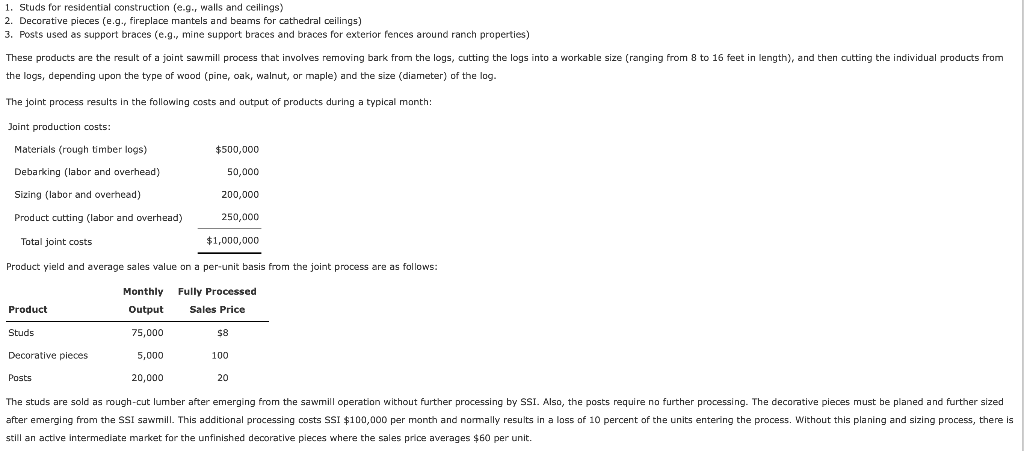


1. Studs for residential construction (e.g., walls and ceilings) 2. Decorative pieces (e.g., fireplace mantels and beams for cathedral ceilings) 3. Posts used as support braces (e.g, mine support bracess and braces for exterior fences around ranch properties) length), and then cutting the individual products from These products are the result of a joint sawmill process that involves removing bark from the logs, cutting the logs into a workable size (ranging from 8 to 1 feet the logs, depending upon the type of wood (pine, oak, walnut, or maple) and the size (diameter) of the log. The joint process results in the following costs and output f products during a typical month: Joint production costs: Materials (rough timber logs) $500,000 Debarking (labor and overhead) 50,000 Sizing (labor and overhead) 200,000 250,000 Product cutting (labor and overhead) 1,000,000 Total joint costs Product yield and average sa les value on a per-unit basis from the joint process are as fol lows: Monthly Fully Processed Sales Price Product Output $8 Studs 75,000 Decorative pieces 5,000 10C Posts 20.000 20 The studs are sold as rough-cut lumber after emerging from the sawmill operation without further processing y SSI. Also, the posts require no further processing. The decorative pieces must be planed and further sized after emerging from the SSI sawmill. This additional processing costs SSI $100,000 per month and nomally results in a loss of 10 percent of the un its entering the process. Without this planing and sizing process, there is still an active intermediate market for the unfinished decorative pieces where the sales price averages $60 per unit. c. Estimated net realizable value method. When required, round decimal values to four places before converting to a percentage. For example, .88349 would be rounded to .8835 and entered as "88.35" percent. Fully Processed Net Reallzable Monthly Sales Price Percent of Estimated Allocated Unit Output per Unit Value Value Joint Costs 44.44 o $444,444.44 X 8 S 75,000 $ Studs 600,000 Decorative 350,000 V% 4,500 100 25.93 259,259.26 x pieces V% 20 V 400,000 306,767 X Posts 20,000 29.63 1,000,000 .350.000 100 Total 2. Prepare an analysis for Sonimad Sawmill, Inc, to compare processing the decorative pieces further as it presently does, with selling the rough-cut product immediately split-off. Sonimad mill Apalvsis Renor Monthly unit output 5,000 Less: Normal further processing shrinkage -500 V Units available for sale 4,500 450,000 Final sales value Less: Sales value at split-off 300,000 Differential revenue 150,000 Less: Further processing costs 120,000 X 30,000 X Additional contribution from further processing









